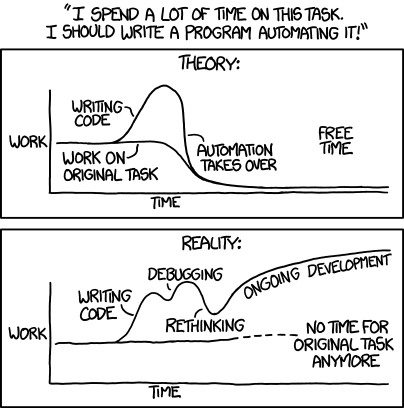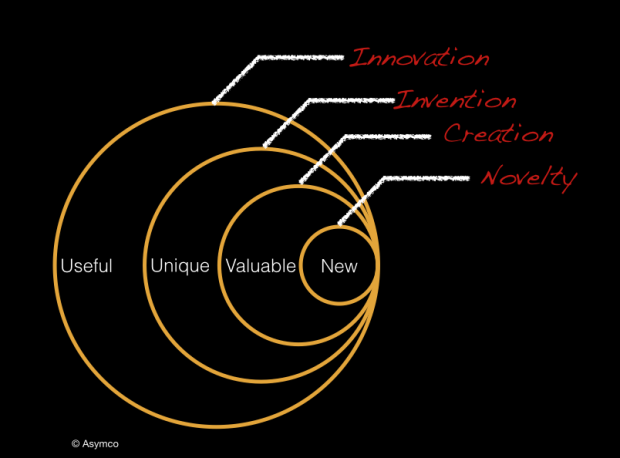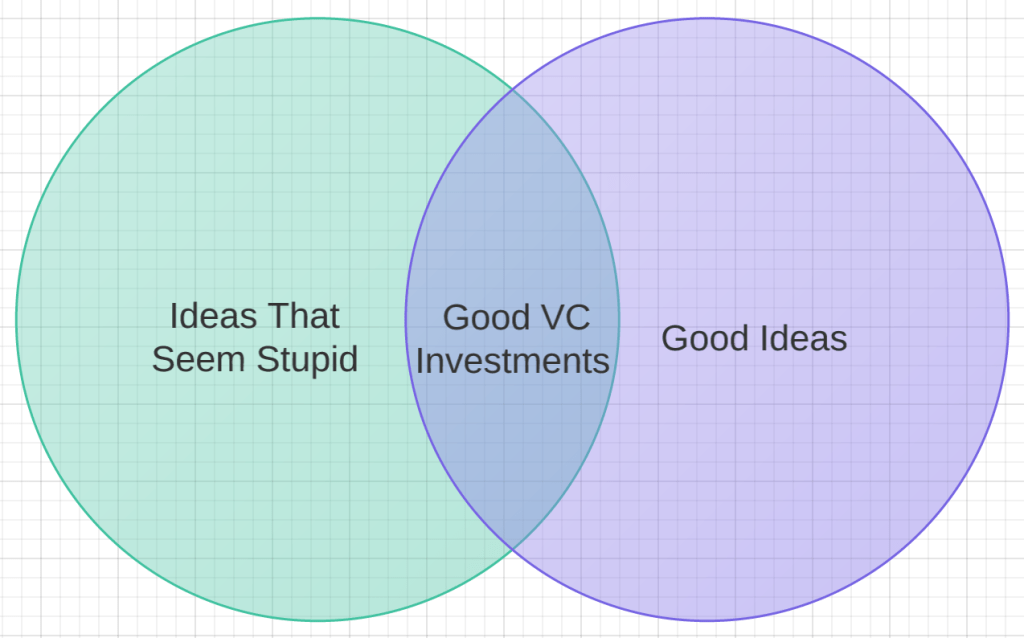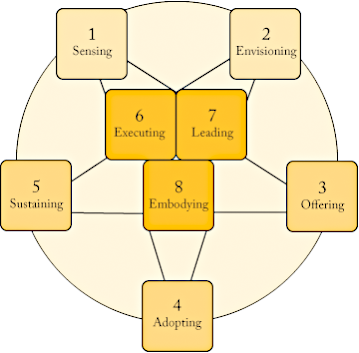Innovation is about finding a better way of doing something. Like many of the new development buzzwords (which many of them are over-used on many business documents), the concept of innovation originates from the world of business. It refers to the generation of new products through the process of creative entrepreneurship, putting it into production, and diffusing it more widely through increased sales. Innovation can be viewed as t he application of better solutions that meet new requirements, in-articulated needs, or existing market needs. This is accomplished through more effective products, processes, services, technologies, or ideas that are readily available to markets, governments and society. The term innovation can be defined as something original and, as a consequence, new, that “breaks into” the market or society.
Innoveracy: Misunderstanding Innovation article points out that there is a form of ignorance which seems to be universal: the inability to understand the concept and role of innovation. The way this is exhibited is in the misuse of the term and the inability to discern the difference between novelty, creation, invention and innovation. The result is a failure to understand the causes of success and failure in business and hence the conditions that lead to economic growth. The definition of innovation is easy to find but it seems to be hard to understand. Here is a simple taxonomy of related activities that put innovation in context:
- Novelty: Something new
- Creation: Something new and valuable
- Invention: Something new, having potential value through utility
- Innovation: Something new and uniquely useful
The taxonomy is illustrated with the following diagram.
The differences are also evident in the mechanisms that exist to protect the works: Novelties are usually not protectable, Creations are protected by copyright or trademark, Inventions can be protected for a limited time through patents (or kept secret) and Innovations can be protected through market competition but are not defensible through legal means.
Innovation is a lot of talked about nowdays as essential to businesses to do. Is innovation essential for development work? article tells that innovation has become central to the way development organisations go about their work. In November 2011, Bill Gates told the G20 that innovation was the key to development. Donors increasingly stress innovation as a key condition for funding, and many civil society organisations emphasise that innovation is central to the work they do.
Some innovation ideas are pretty simple, and some are much more complicated and even sound crazy when heard first. The is place for crazy sounding ideas: venture capitalists are gravely concerned that the tech startups they’re investing in just aren’t crazy enough:
Not all development problems require new solutions, sometimes you just need to use old things in a slightly new way. Development innovations may involve devising technology (such as a nanotech water treatment kit), creating a new approach (such as microfinance), finding a better way of delivering public services (such as one-stop egovernment service centres), identifying ways of working with communities (such as participation), or generating a management technique (such as organisation learning).
Theorists of innovation identify innovation itself as a brief moment of creativity, to be followed by the main routine work of producing and selling the innovation. When it comes to development, things are more complicated. Innovation needs to be viewed as tool, not master. Innovation is a process, not a one time event. Genuine innovation is valuable but rare.
There are many views on the innovation and innvation process. I try to collect together there some views I have found on-line. Hopefully they help you more than confuze. Managing complexity and reducing risk article has this drawing which I think pretty well describes innovation as done in product development:
8 essential practices of successful innovation from The Innovator’s Way shows essential practices in innovation process. Those practices are all integrated into a non-sequential, coherent whole and style in the person of the innovator.
In the IT work there is lots of work where a little thinking can be a source of innovation. Automating IT processes can be a huge time saver or it can fail depending on situation. XKCD comic strip Automation as illustrates this:

System integration is a critical element in project design article has an interesting project cost influence graphic. The recommendation is to involve a system integrator early in project design to help ensure high-quality projects that satisfy project requirements. Of course this article tries to market system integration services, but has also valid points to consider.
Core Contributor Loop (CTTDC) from Art Journal blog posting Blog Is The New Black tries to link inventing an idea to theory of entrepreneurship. It is essential to tune the engine by making improvements in product, marketing, code, design and operations.






5,690 Comments
Tomi Engdahl says:
Liquid metal based electrical driven shape memory polymers
https://www.sciencedirect.com/science/article/abs/pii/S003238612030999X?fbclid=IwZXh0bgNhZW0CMTEAAR1txyovox9e8fCPz3HzSz8Vt3SLcq1DvTLm83vO-dFsBvz0OitdERB7BE4_aem_AXyBxCiZtquHZiAR4GYtMoXkeC0ktUM5EEsgwVd00w5BQ7HT025OsOZBiSmPphSJH12Do9oB4nQo77MDGMeO5_na
Highlights
•
Liquid metal was introduced into the typical shape memory polymer, polycaprolactone.
•
The resulted LM-SMP exhibited excellent shape memory performance.
•
The bilayer LM-SMP composite showed reversible actuation under elelctrical stimulation.
Tomi Engdahl says:
https://hackaday.com/2024/05/18/students-leaf-blower-suppressor-to-hit-retail/
Tomi Engdahl says:
https://hackaday.com/2024/05/19/mobius-string-robot-goes-round-and-round/
Tomi Engdahl says:
MIT repurposes beer yeast to feast on deadly lead contaminates in water
MIT team states that this cost-effective solution could benefit low-income regions with heavy lead water pollution.
Updated: May 16, 2024 01:53 AM EST
https://interestingengineering.com/science/mit-yeast-lead-water
Tomi Engdahl says:
Breaking exascale barrier: US tops supercomputer list with Frontier, Aurora
The Aurora supercomputer reached a performance milestone of 1.012 exaflops, making it one of only two officially recognized exascale systems globally.
Updated: May 14, 2024 07:39 AM EST
https://interestingengineering.com/science/top-supercomputer-frontier-aurora
Tomi Engdahl says:
https://www.sciencealert.com/physicists-detect-hints-of-a-mysterious-particle-called-a-glueball
Tomi Engdahl says:
https://thedebrief.org/warp-drive-breakthrough-could-enable-constant-velocity-subluminal-travel-physics-team-says/
Tomi Engdahl says:
Scientists prove ‘quantum theory’ that could lead to ultrafast magnetic computing
News
By Peter Ray Allison published May 16, 2024
Superfast magnetic memory devices are possible after scientists engineer way to use lasers to magnetize non-magnetic materials.
https://www.livescience.com/technology/computing/scientists-prove-quantum-theory-that-could-lead-to-ultrafast-magnetic-computing
Tomi Engdahl says:
https://www.iflscience.com/whats-going-on-with-the-new-covid-flirt-variants-74245
Tomi Engdahl says:
VTT:llä saa mokata, sanoo toimitusjohtaja Antti Vasara, koska erehdyksessä voi olla innovaation siemen
VTT:n toimitusjohtaja Antti Vasaran mukaan mokaaminen on opettavaista ja kuuluu tutkijan työhön, ja siksi sitä ei saa pelätä. Toimitusjohtaja itse mokaa kerran tunnissa, ja yksi erhe harmittaa edelleen.
https://www.op-media.fi/johtaminen/vttlla-saa-mokata-sanoo-toimitusjohtaja-antti-vasara/
Tomi Engdahl says:
‘No One Cares Anymore’: The Mandalorian’s Bill Burr Says Cancel Culture Is Over
BY
JEREMY DICK
PUBLISHED 7 DAYS AGO
The Mandalorian actor and controversial comedian Bill Burr says the era of cancel culture is finished.
https://www.cbr.com/bill-burr-cancel-culture-over/#Echobox=1715645695
Tomi Engdahl says:
https://phys.org/news/2024-05-physicists-metro-area-quantum-network.html
Tomi Engdahl says:
https://www.sciencealert.com/scientists-discovered-an-amazing-practical-use-for-leftover-coffee-grounds
We could be producing concrete that’s 30 percent stronger by processing and adding charred coffee grounds to the mix, researchers in Australia discovered.
Their clever recipe could solve multiple problems at the same time.
Tomi Engdahl says:
Just believing that an AI is helping boosts your performance
Minna Tiainen
Published: 13.5.2024
People perform better if they think they have an AI assistant – even when they’ve been told it’s unreliable and won’t help them
https://www.aalto.fi/en/news/just-believing-that-an-ai-is-helping-boosts-your-performance
Tomi Engdahl says:
https://www.boredpanda.com/interesting-parenting-charts/
Tomi Engdahl says:
https://scienceblog.com/544062/researchers-discover-protective-quantum-effect-in-the-brain/
Tomi Engdahl says:
https://www.livescience.com/physics-mathematics/quantum-physics/stunning-image-shows-atoms-transforming-into-quantum-waves-just-as-schrodinger-predicted
Tomi Engdahl says:
https://futurism.com/the-byte/earthquakes-caused-mysterious-blobs-earth
Tomi Engdahl says:
https://www.helsinki.fi/fi/uutiset/kestavyysmurros/kulta-hopea-ja-kupari-voidaan-liuottaa-kierratysmateriaaleista-aiempaa-kestavammilla-menetelmilla?fbclid=IwAR0bjUOAzcyIt8RUVTNAgPMVTf7HrmPWbAEhsmfTmlXpedy6cgyWSLcyMZw_aem_AZM9sJM9hsBW_uPZ8SPYCKAZi8qbidIcn-oGCtOy3P0wpsXJCJ_UISLrwyLHzMdezBfDsN0DMvyXHLHvkpwVJ8Vt&utm_medium=paid&utm_source=fb&utm_id=6567101323596&utm_content=6625327074196&utm_term=6625327073596&utm_campaign=6567101323596
Tomi Engdahl says:
Full scan of 1 cubic millimeter of brain tissue took 1.4 petabytes of data, equivalent to 14,000 4K movies — Google’s AI experts assist researchers
News
By Dallin Grimm published May 10, 2024
Mind-boggling mind research.
https://www.tomshardware.com/tech-industry/full-scan-of-1-cubic-millimeter-of-brain-tissue-took-14-petabytes-of-data-equivalent-to-14000-full-length-4k-movies
Tomi Engdahl says:
A Staggering 19x Energy Jump in Capacitors May Be the Beginning of the End for Batteries
It opens the door to a new era of electric efficiency.
https://www.popularmechanics.com/science/a60732620/capacitor-energy-storage-breakthrough/
Tomi Engdahl says:
Mapping The Human Brain And Where This May Lead Us
https://hackaday.com/2024/05/23/mapping-the-human-brain-and-where-this-may-lead-us/
design build says:
Transform your vision into reality with Lavan Construction, a top California design build company. We specialize in creating custom-built homes in the Bay Area, offering seamless integration of design and construction with meticulous attention to detail and exceptional craftsmanship.
Tomi Engdahl says:
Tukholmalaisen kuninkaallisen teknisen korkeakoulun tutkijat ovat onnistuneet valmistamaan 3D-tulostamalla rakenteita optisten kuitujen kärkiin. Läpimurto voi johtaa suurempiin internetnopeuksiin ja parannettuihin yhteyksiin sekä pienempien antureiden ja kompaktimpien kuvantamisjärjestelmien kehittämiseen.
https://etn.fi/index.php/13-news/16260-ruotsalaiskeksintoe-voi-tehdae-koko-internetistae-nopeamman
Tomi Engdahl says:
Whole-Fruit Chocolate: Skipping The Sugar By Using The Entire Cacao Pod
https://hackaday.com/2024/05/28/whole-fruit-chocolate-skipping-the-sugar-by-using-the-entire-cacao-pod/
It’s hard to imagine a world without chocolate, and yet it is undeniable that there are problems associated both with its manufacturing and its consumption. Much of this is due to the addition of sugar, as well as the discarding of a significant part of the cacao pod, which harbors the pulp and seeds. According to a study by [Kim Mishra] and colleagues in Nature Food, it might be possible to ditch the sugar and instead use a mixture of cacao pulp juice (CPJC) and endocarp powder (ECP), which are turned into a sweetening gel.
This gel replaces the combination of sugar with an emulsifier (lecithin or something similar) in current chocolate while effectively using all of the cacao pod except for the husk. A lab ran a small-scale production, with two different types of whole-fruit chocolate produced, each with a different level of sweetness, and given to volunteers for sampling.
Tomi Engdahl says:
Liquid metal based electrical driven shape memory polymers
https://www.sciencedirect.com/science/article/abs/pii/S003238612030999X
Tomi Engdahl says:
https://www.iflscience.com/the-math-problem-so-hard-we-had-to-invent-new-numbers-61503
Tomi Engdahl says:
https://hackaday.com/2024/05/29/can-you-hear-me-now-try-these-headphones/
When you are young, you take it for granted that you can pick out a voice in a crowded room or a factory floor. But as you get older, your hearing often gets to the point where a noisy room merges into a mishmash of sounds. University of Washington researchers have developed what they call Target Speech Hearing. In plain English, it is an AI-powered headphone that lets you look at someone and pull their voice out of the chatter. For best results, however, have to enroll their voice first, so it wouldn’t make a great eavesdropping device.
Tomi Engdahl says:
Data Is the New Oil–Sort of: A View on Why This Comparison Is Misleading and Its Implications for Modern Data Administration
https://www.mdpi.com/1999-5903/15/2/71?utm_campaign=journnews_ccbj_futureinternet&utm_medium=social_journ&utm_source=facebook&fbclid=IwAR2N1fMCyFZIJDSvrukHdSglcpBqNqPncNSQ7U5KpOLGQJIuCVPnvsRgby4_aem_AYaXp1G297NfSRSRGg8PSIbt-vtlH4zBJ1Sl0pVtzf4ya3RMstD41C-5AATMoap4JJAB5vyHBg5niyWTHZT8nG4B
Tomi Engdahl says:
Trailblazers in Science: 10 Women in STEM Who Shaped the World
https://www.thermofisher.com/blog/life-in-the-lab/trailblazers-in-science-10-women-in-stem-who-shaped-the-world/
Tomi Engdahl says:
In a first, scientists light up blue LED with an AA battery
Conventional LEDs require 4V for luminance, which is higher than the industry target of 3.7 V that a lithium-ion battery can provide.
https://interestingengineering.com/innovation/blue-led-ultralow-turn-on-voltage
cientists at the Tokyo Institute of Technology (TIT), in collaboration with other universities in Japan, have developed a novel organic light-emitting diode (LED) that emits blue fluorescence but has a low turn-on voltage, a press release said.
LEDs are crucial components of modern electronic displays, whether in pocket-sized devices such as smartphones or in giant-sized screens used for advertising on billboards.
Tomi Engdahl says:
Breakthrough all-solid-state Sodium-air battery offers high-energy
Researchers at POSTECH have made a groundbreaking discovery in battery technology, developing a high-energy, high-efficiency all-solid-state sodium-air battery
https://interestingengineering.com/energy/breakthrough-solid-sodium-air-battery
Tomi Engdahl says:
https://thedebrief.org/discovery-of-supercapacitors-missing-link-moves-laptops-that-charge-in-1-minute-closer-to-reality/
Tomi Engdahl says:
16 lab-grown brains run world’s first ‘living computer’ in Switzerland
While training AI models consumes 6,000 times more than a European city, bioprocessor promise drastic savings in energy expenditures.
https://interestingengineering.com/innovation/worlds-first-living-computer-switzerland
Tomi Engdahl says:
Breakthrough Swiss tech cuts 80% of radioactive waste in nuclear plants
Radioactivity of nuclear waste could be reduced from thousands of years to less than 500 years.
https://interestingengineering.com/innovation/nuclear-waste-reduction-tech
Tomi Engdahl says:
https://www.cracked.com/pictofacts-1542-famous-artists-who-hated-their-most-famous-work
Tomi Engdahl says:
https://www.iflscience.com/scientists-have-discovered-a-new-way-to-count-and-its-actually-really-important-74327?fbclid=IwZXh0bgNhZW0CMTEAAR3VHG-ui0zoHS-Lz6rSHh_HCuznXl1jnDs5EjQiOleslZ2Mws2CljX-z0o_aem_ZmFrZWR1bW15MTZieXRlcw
Tomi Engdahl says:
https://www.newscientist.com/article/mg26234921-800-how-quantum-entanglement-really-works-and-why-we-accept-its-weirdness/
Tomi Engdahl says:
Tackling ‘wicked’ problems calls for engineers with social responsibility
Many technologies are high-risk, and their problems cannot be fixed by policy alone; engineers must embrace social responsibility.
https://www.nature.com/articles/d41586-024-01519-1#Echobox=1716889229-1
Society relies on engineers to deliver almost everything it uses, from food and water to buildings, transport and telecommunications. But new technologies are often rushed into service, for market reasons, before potential risks and consumer behaviours are understood, and well before sufficient regulation is put in place to protect the public.
Madhavan focuses on ‘wicked problems’, which emerge “when hard, soft and messy problems collide”. Time and time again, a technology becomes profitable and is widely adopted, then its problems become clear and public alarm grows. A period of debate follows, marked by inflamed emotions, news coverage, litigation, denial of responsibility and political impotence. Eventually, corrective mechanisms are developed, implemented and enforced with updated standards. These patterns and problems of rapid technological development are becoming recognized. And there are plenty of modern examples, from social-media platforms and artificial-intelligence systems to self-driving cars.
But why was it normal to accept vulnerability — why did workers and managers ignore the warning signs? A social-responsibility code was needed to tackle the soft problems of human error and risk normalization, as well as the vague problems of greed, mismanagement and hubris. Had such a code existed, it would also have spoken to the ‘messy’ problem of colonial exploitation in sugar-cane-exporting countries. Madhavan brings attention to the need for engineers to take on social responsibility.
Madhavan explores six facets of wicked problems — efficiency, vagueness (about the nature of the problem), vulnerability, safety, maintenance and resilience. Risks are impossible to eliminate, but they can be diminished through ‘mindful’ processes (in which workers have time to run through checklists and identify hazards), workplace cultures of humility and continuous learning, and robust, responsive work structures, such as whiteboards on which issues can be recorded, with processes to stop work to check and report errors.
Of course, high-pressure-steam science and pressure-vessels engineering have improved since then — but Leveson points out that the real transition has been in culture. These explosions went from being a tragedy to being unacceptable.
Flying was so unsafe in the 1960s that in the United States, only one in five people was willing to fly.
Madhavan threads the story of US aviation pioneer Edwin Link throughout the book to explore how a systems approach is needed to address wicked problems. As well as being a pilot, Link was an inventor, entrepreneur and adventurer with a strong sense of responsibility.
The scholarship application asked candidates to discuss how their vision for research was guided by social responsibility — now I know why.
Madhavan champions the importance of looking at seemingly technical problems through a wider lens — such as the business, policy and social aspects. He makes the case for investing in engineering-research programmes to develop the holistic approaches and methods needed to address wicked problems.
Wicked Problems is a wake-up call for all engineers to expand their mindset. Although I wish that Madhavan’s book had gone a step further,
Tomi Engdahl says:
Microplastics Found in Blood Clots in Heart, Brain, And Legs
https://www.sciencealert.com/microplastics-found-in-blood-clots-in-heart-brain-and-legs
Tomi Engdahl says:
Atoms squished closer together than ever before, revealing seemingly impossible quantum effects
https://www.livescience.com/physics-mathematics/quantum-physics/atoms-squished-closer-together-than-ever-before-revealing-seemingly-impossible-quantum-effects
Tomi Engdahl says:
“It is estimated that living neurons can use over 1 million times less energy than the current digital processors we use.” https://trib.al/F4nTVDQ
Tomi Engdahl says:
The effects of acute exercise on cognitive performance: A meta-analysis
https://www.sciencedirect.com/science/article/abs/pii/S0006899312004003
Tomi Engdahl says:
Water engine on the move for the first time in history: better than hydrogen and breaks power records
https://www.ecoticias.com/en/water-engine-hydrogen-history/2379/
How does the water engine that is revolutionizing the hydrogen market work?
The Port Fuel Injection or PFI inserts traditional water into the engine’s air intake system, which prevents premature ignition that could damage the part and achieves stoichiometric combustion. Translated, this means that the resulting proportions of air and fuel are more or less fixed.
This, the company explains, highlights the potential disadvantages of lean-burn engines. The result of this extensive work has been a two-liter hydrogen engine that produces 410 hp and 500 Newton-meters of torque between 3,000 and 4,000 revolutions per minute, achieving a specific power density of approximately 205 hp per liter (150 kW per liter).
AVL guarantees, based on actual tests, that the engine will be able to compete in top-level motor racing.
Tomi Engdahl says:
https://interestingengineering.com/innovation/water-from-air-tech-too-expensive
Tomi Engdahl says:
https://framian.fi/ideasta-tuote/
Tomi Engdahl says:
Time may be an illusion created by quantum entanglement
The true nature of time has eluded physicists for centuries, but a new theoretical model suggests it may only exist due to entanglement between quantum objects
https://www.newscientist.com/article/2433294-time-may-be-an-illusion-created-by-quantum-entanglement/
Tomi Engdahl says:
What is Digital Twin Technology?
Digital twins are realistic digital representations of something in the physical world. They are rapidly being developed and shaking up industries, including healthcare, manufacturing, and city design. Digital twin technology intersects with advances in artificial intelligence, next-generation mobile communications, big data, and more.
https://mdpiblog.wordpress.sciforum.net/2024/04/15/digital-twin/
Tomi Engdahl says:
Lehti: Lakritsituotteisiin varoitusteksti? – Haitallinen vaikutus voi kestää viikkoja
Lakritsia on myös sellaisissa tuotteissa, joita myydään terveyttä edistävinä.
https://www.iltalehti.fi/elintavat/a/a61fb055-7e93-4e69-b7aa-5cae8f6965aa
Lakritsi voi johtaa jo yllättävän pieninä määrinä nautittuna merkittävään hypokalemiaan, joka voi pahimmillaan aiheuttaa pahanlaatuisen rytmihäiriön.
Näin todetaan Duodecim-lehden pitkässä artikkelissa, joka kertoo lakritsioireyhtymästä.
Lakritsioireyhtymä
https://www.duodecimlehti.fi/lehti/2024/11/duo18281
Lakritsituotteiden sisältämän glykyrritsiinin aktiivinen aineenvaihduntatuote glykyrretiinihappo estää 11-beeta-hydroksisteroididehydrogenaasi (11β-HSD2) -entsyymiä, joka inaktivoi kortisolia kortisoniksi. Entsyymin toiminnan estymisestä seuraa lisääntynyt mineralokortikoidivaikutus, jonka tärkeimmät ilmentymät ovat hypokalemia ja kohonnut verenpaine. Lakritsioireyhtymän selvittelyssä keskeistä on anamneesi. Lakritsioireyhtymässä sekä reniini- että aldosteronipitoisuudet ovat pieniä. Lakritsin epäsuotuisat vaikutukset voivat kestää jopa viikkojen ajan ja johtaa hengenvaarallisiin rytmihäiriöihin. Hoidossa kaliumpitoisuuden tiivis seuranta on välttämätöntä. Herkkyys lakritsin vaikutuksille on yksilöllistä, eikä varmuudella turvallista lakritsimäärää ruokavaliossa voitane määrittää.
Suomalaiset syövät runsaasti makeisia, joista suosituimpien joukossa ovat erilaiset lakritsiuutetta sisältävät lakritsituotteet ja salmiakkimakeiset (S-ryhmän julkinen tiedonanto). Lakritsi sisältää glykyrritsiiniä, jonka aktiivinen aineenvaihduntatuote on glykyrretiinihappo (glycyrrhetinic acid) ja jonka määrä lakritsituotteissa voi vaihdella merkittävästikin (1). Lakritsia ja glykyrritsiiniä on toisaalta monissa muissakin tuotteissa, esimerkiksi erilaisissa maustetuissa tee- tai haudukejuomissa, purukumeissa, yskänlääkkeissä ja luontaistuotteissa (2).
Lakritsin verenpainetta nostava sekä veren kaliumpitoisuutta pienentävä vaikutus on tunnettu pitkään.
Tomi Engdahl says:
https://hackaday.com/2024/06/03/tech-in-plain-sight-theodolites/